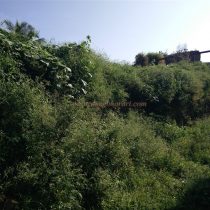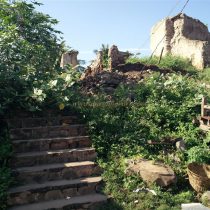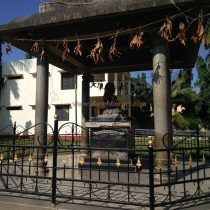BAILHONGAL
TYPE : GROUND FORT
DISTRICT : BELGAON
HEIGHT : 0
GRADE : EASY
When someone says Bailhongal we remember the battle of Queen Chenamma of Kittur with the British just like Queen Lakshmibai of Jhansi. After the fall of Kittur, the queen was imprisoned in the fort at Bailhongal and she died there. After seeing the history of Rani Chennamma and the record of Bailhongal fort in it, we visited Bailhongal fort while visiting Belgaon fort. Bailhongal ground fort was once in Bailhongal taluka of Belgaon district. At a distance of 50 km from Belgaon is the town of Bailhongal, and today there is nothing left on the fort except a small bastion and a small wall. A place on Google showing the ramparts of Bailhongal Fort brings you directly to this crumbling bastion, but when you come here, you might get disappointed. Today there is nothing like a fort left here.
...
At a distance of about 150 feet from this small bastion is well with carved steps. Once this well was inside the fort but due to urbanization all the remains of the fort have been destroyed and lost. A short distance from the fort is the Samadhi of Queen Chenamma and the government has erected a statue of her and a garden there. You should visit this Samadhi of Queen Chenamma and get your fort round ends. Although it is not known exactly when the Bailhongal fort was built, it was an important fort in the Kittur kingdom. Bailhongal fort became famous due to the battle fought by Rani Chenamma from this fort. During the Adilshahi period, this region was included in the patriotic lands of the Lingayat brothers Hiramallappa and Chikkamallappa. This family had the title of Sarja. From Adilshahi to the Maratha rule, there were twelve Desai in this family for about 239 years. In 1756, the Marathas took over the province of Nawab of Savnur, but they kept the lands of Kittur and Gokak under the control of the native Desai. In 1785, Tipu conquered Kittur. After being defeated by the Marathas in 1792, this part came back to the Marathas according to the treaty of Srirangapatna. Queen Chennamma, popularly known as the Queen of Kittur, was born on 23 October 1778 in the village of Kakati in Belgaon district. At the age of 15, she married Raja Mallasarja of the Desai family. King Mallasarja died in 1824, and his son died shortly afterward. After the death of her son, Queen Chennamma ascended the throne of Kittur. Shivalingappa was adopted in 1824, but Thackeray, the British Collector of Dharwad of the British East India Company, rejected the adoption and annexed the Kittur Sansthan and tried to confiscate Kittur's treasures and jewelry. On this Queen, Chennamma revolted against the British and gave an armed fight with the help of General Sangoli Rayanna. This rebellion is known as the Battle of Kittur. In this war, Queen Chennamma herself fought the British on horseback. For this, she took refuge in Bailhongal fort. On October 1, 1824, British troops were defeated in the first round of the war. Thackeray was killed in the battle, and two English officers, Walter Elliott and Mr. Stevenson were taken, prisoner. The next day the British attacked with full force and captured Bailhongal fort. Queen Chennamma was arrested by the British and imprisoned at Bailhongal Fort. She died on 21 February 1829 and was buried at Bailhongal. Her tomb has been preserved and a small statue and garden have been erected there. This place is a must also be visited if you are visiting Belgaon.
© Suresh Nimbalkar




